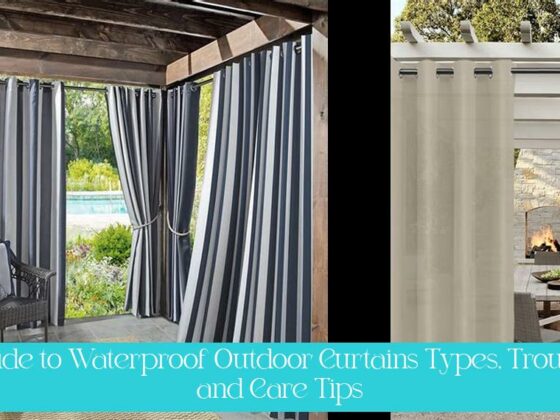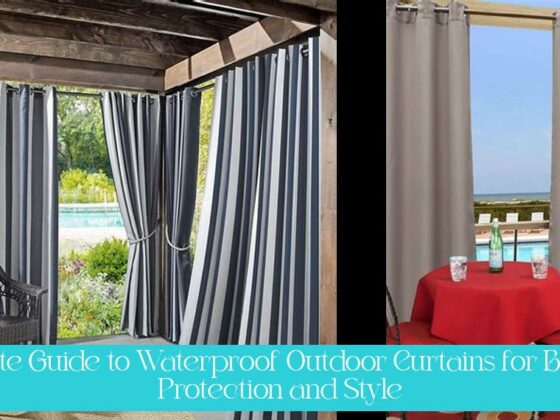Welcome to the ultimate guide to outdoor curtains! If you’ve ever yearned for an outdoor oasis that offers both privacy and protection from the elements, then you’re in the right place. From choosing the perfect fabric to hanging them securely, we’ve got you covered. So, grab a seat, and let’s dive into the world of outdoor curtains and how they can redefine your outdoor space.
Key Takeaways
Lisez aussi Upgrade Your Space with Stylish Brass Curtain Rods from IKEA: The Ultimate Guide
- Outdoor curtains are a great way to define outdoor spaces, providing privacy and blocking harsh sunlight.
- It is best to use fabrics that dry quickly or do not absorb water, such as synthetics, for outdoor curtains.
- Using cables or wires to hang outdoor curtains is one of the best ways to prevent them from blowing in the wind.
- Outdoor curtains that get soaked and stay wet for hours, especially in humid climates, are at risk of developing mold and mildew.
- When looking for outdoor curtains, consider options that are waterproof and offer easy light control for adjusting sunlight and heat.
Outdoor Curtains: Defining Your Outdoor Oasis

Outdoor curtains, an elegant and practical addition to any outdoor space, offer a myriad of benefits. Whether you’re seeking privacy, sun protection, or a touch of ambiance, outdoor curtains are a versatile solution that can transform your patio, deck, or garden into a cozy and inviting retreat.
Recherches associées – Effortless Elegance: The Ultimate Guide to Automatic Curtain Openers for Your Smart Home
Choosing the Right Fabric for Outdoor Curtains
The durability and longevity of your outdoor curtains largely depend on the fabric you choose. Opt for fabrics that are designed to withstand the elements, such as:
-
Synthetics: Synthetic materials, like polyester and acrylic, are known for their water resistance, quick-drying properties, and resistance to fading.
-
Waterproof Fabrics: Waterproof fabrics, such as vinyl and canvas, provide excellent protection against moisture, preventing mildew and mold growth.
Avoid fabrics that absorb water, like cotton and canvas, as they can become heavy and prone to mold and mildew in humid environments.
Pour les curieux, Transform Your Bathroom with Vibrant Summer Shower Curtains: A Complete Guide
Hanging Outdoor Curtains: Wind-Resistant Solutions

Preventing your outdoor curtains from blowing in the wind is crucial for both aesthetics and functionality. Consider these effective methods:
-
Cables or Wires: Threading cables or wires through the curtain’s grommets or loops and securing them to anchors on both sides of the opening is a sturdy and wind-resistant solution.
-
Weighted Hems: Weighted hems add stability to the curtains, preventing them from billowing in the wind.
-
Tie-Downs: Using tie-downs to secure the curtains to the ground or nearby structures provides additional wind resistance.
Maintaining Outdoor Curtains: Preventing Mold and Mildew
To ensure the longevity of your outdoor curtains and prevent the growth of mold and mildew, follow these maintenance tips:
— Revamp Your Home Decor with Urban Outfitters Curtains Sale: Stylish and Affordable Options Await!
-
Regular Cleaning: Regularly cleaning your curtains with a mild detergent and water will remove dirt and debris that can trap moisture and promote mold growth.
-
Avoid Soaking: Avoid soaking outdoor curtains for extended periods, as this can damage the fabric and promote mold growth.
-
Proper Drying: Ensure that your curtains dry completely before storing them to prevent mildew and mold formation.
-
Consider Mold-Resistant Fabrics: Choose fabrics with built-in mold and mildew resistance for added protection in humid environments.
Are outdoor curtains a good idea?
Outdoor curtains are a great way to define your outdoor space. This finishing touch can help to provide privacy or block harsh sunlight.
What material should outdoor curtains be?
It is best to stick with fabrics that dry quickly or do not absorb water. This usually means synthetics for outdoor curtains. Cotton and canvas absorb a lot of water and will not dry quickly, putting them at higher risk for developing mold and mildew.
How do I keep my outdoor curtains from blowing in the wind?
Cables or wires are one of the best ways to hang outdoor curtains. First, you have to drill 2 holes to 2 sides and mount screws into them. Now thread the curtain into the cable or wire. Then you have to tie the cable on both sides to the screws with the required amount of tension.
What are some wind-resistant solutions for hanging outdoor curtains?
Effective methods for preventing outdoor curtains from blowing in the wind include threading cables or wires through the curtain’s grommets or loops and securing them to anchors on both sides of the opening, adding weighted hems for stability, and using tie-downs to secure the curtains to the ground or nearby structures.
How do you maintain outdoor curtains to prevent mold and mildew?
To prevent the growth of mold and mildew, regularly clean your curtains with a mild detergent and water to remove dirt and debris that can trap moisture and promote mold growth. Additionally, avoid fabrics that absorb water, such as cotton and canvas, as they can become heavy and prone to mold and mildew in humid environments.
What are the key benefits of outdoor curtains?
Outdoor curtains are a versatile solution that can transform your patio, deck, or garden into a cozy and inviting retreat. They provide privacy, sun protection, and a touch of ambiance, making them an elegant and practical addition to any outdoor space.









